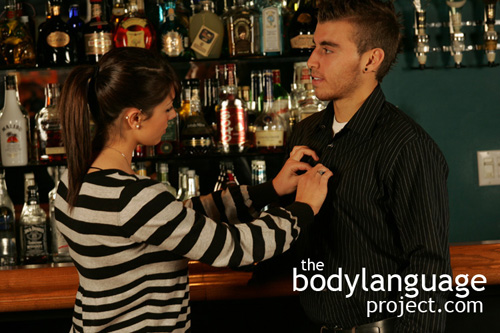Body Language of Grooming and Preening
Synonym(s): Preening.
Description: A gesture that aims to make the self or someone else more presentable. It includes removing lint or pet hair, fixing a tag from a shirt, smoothing clothing, adjusting a shirt collar, fixing the hair, applying makeup, checking a mirror, and so forth.
In One Sentence: Grooming other people is a way to bond and when done on the self, is a way to make yourself presentable.
How To Use it: Use grooming of yourself to show other people that you are in good health and care about how you are presented. This is important in every facet of one’s life from intimate relationships to job settings.
In dating as well as between friends and relatives, grooming is a welcome form of caring and demonstration of respect. To show people you care, remove lint, smooth clothing, adjusting a tie, notify them of stains on clothing or food on their face and so forth. Some debate exists as to whether we should risk the embarrassment by helping people self-groom, however, it is usually well received. Think of grooming as a way to help people avoid extra embarrassment. At the same time, grooming shows people that you are looking out for them.
The gesture is particularly important in a dating context since it shows the opposite sex that you really care about them. Men and women can both groom each other to show intimacy.
Context: a) General b) Dating.
Verbal Translation: a) “I’m fixing my body up so I seem more attractive and presentable because I want others to view me in a positive light.” b) “I’m fixing your body, by grooming you, because I care about you and how you look and how you feel.”
Variant: See Invisible Lint Picker or Lint Picker.
Cue In Action: a) She pardoned herself from the conversation and reapplied make-up as the rain had washed most of it off. b) He straightened his tie and buttoned up his jacket before giving her a hug and kiss. c) Mom went over to her son and brushed him off. He had leaves all over the back of his shirt.
Meaning and/or Motivation: Grooming and preening says that a person is keeping their outward appearance clean and presentable to show the world that they are in good mental health and, or, a good mate. It tells others that they care about how they are viewed by others and that they are social and amicable.
Preening and grooming can also be one on other people. In this case, it means that a person really cares about someone else and that they want to bond by keeping them healthy. This is an evolutionary throwback to removing bugs as monkeys do today. Preening someone else is a way to form a strong bond between two people. A mother might groom her son and a wife might groom her husband. The context will define its meaning.
When grooming is not required or done to excess in front of another person, it signals distain. Such is the case with removing imaginary lint or picking the fingernails. These are all forms of grooming that should be done in private. If they are done in front of people while avoiding eye contact, and opting out of the conversation, it sends a strong message of disrespect.
Cue Cluster: The cue cluster in which preening appears will depend on its intent. When it is designed to improve outward appearance, then eye contact will continue, a person will continue to pay attention or they will excuse themselves in order to preen. When someone wishes to use grooming in a way as to be dismissive, they will break eye contact, while feigning agreement indicators, or conversely, not even pretend to care about what the other person is saying. Other sexual cues will be present in a dating context to indicate that grooming is sexual in nature.
Body Language Category: Courtship displays, Indicators of sexual interest (IOsI), Liking, Ownership gestures, Preening.
Resources:
Cantor, Michael B. ; Smith, Stephen E. ; Bryan, Bonita R. Induced bad habits: Adjunctive ingestion and grooming in human subjects. Appetite. 1982. 3(1): 1-12.
Curtis, V., & Biran, A. (2001). Dirt, disgust, and disease: Is hygiene in our genes? Perspectives in biology
and medicine, 44(1), 17–31.
de Waal, F. (1997). The chimpanzee’s service economy: Food for grooming. Evolution & Human Behavior, 18, 375–386.
Dunbar, R. (1996). Grooming, gossip and the evolution of language. London: Faber and Faber.
Givens D. The nonverbal basis of attraction: Flirtation, courtship, and seduction. Psychiatry. 1978. 41: 346.
Hosey, Geoffrey ; Thompson, Robin. Grooming and touching behaviour in captive ring-tailed lemurs ( Lemur catta L.). Primates. 1985. 26(1): 95-98.
Hazan, C., & Shaver, P. (1987). Romantic love conceptualized as an attachment process. Journal of Personality and Social Psychology, 52, 511–524.
Ingmanson, E. Cultural transmission of a communicative gesture in a captive group of bonobos (Pan paniscus).(Abstract). American Journal of Physical Anthropology. 2002. 117(4): 88(1).
Kinzey, W., & Wright, P. (1982). Grooming behavior in the titi monkey, Callicebus torquatos. American Journal of Primatology, 3, 267–275.
Moore, Monica. Courtship Signaling and Adolescents: Girls Just Wanna Have Fun. Journal of Sex Research. 1995. 32(4): 319-328.
http://bodylanguageproject.com/articles/girls-just-want-to-have-fun-the-origins-of-courtship-cues-in-girls-and-women/
Nelson, Holly ; Geher, Glenn. Mutual Grooming in Human Dyadic Relationships: An Ethological Perspective. Current Psychology. 2007. 26(2): 121-140.
Rempel, J., Holmes, J., & Zanna, M. (1985). Trust in close relationships. Journal of Personality and Social Psychology, 49, 95–112.
Shimooka, Yukiko ; Nakagawa, Naofumi. Functions of an unreported “rocking-embrace” gesture between female Japanese Macaques ( Macaca fuscata ) in Kinkazan Island, Japan. Primates. 2014. 55(2): 327-335.
Thompson, Kristin. Grooming the Naked Ape: Do Perceptions of Disease and Aggression Vulnerability Influence Grooming Behaviour in Humans? A Comparative Ethological Perspective. Current Psychology. 2010. 29(4): 288-296.
Wachtmeister, C. (2001). Display in monogamous pairs: A review of empirical data and evolutionary explanations. Animal Behaviour, 61(5), 861–868.
Wilkinson, G. S. (1986). Social grooming in the common vampire bat, Desmodus rotundus. Animal Behaviour, 34(6), 1880–1889.

